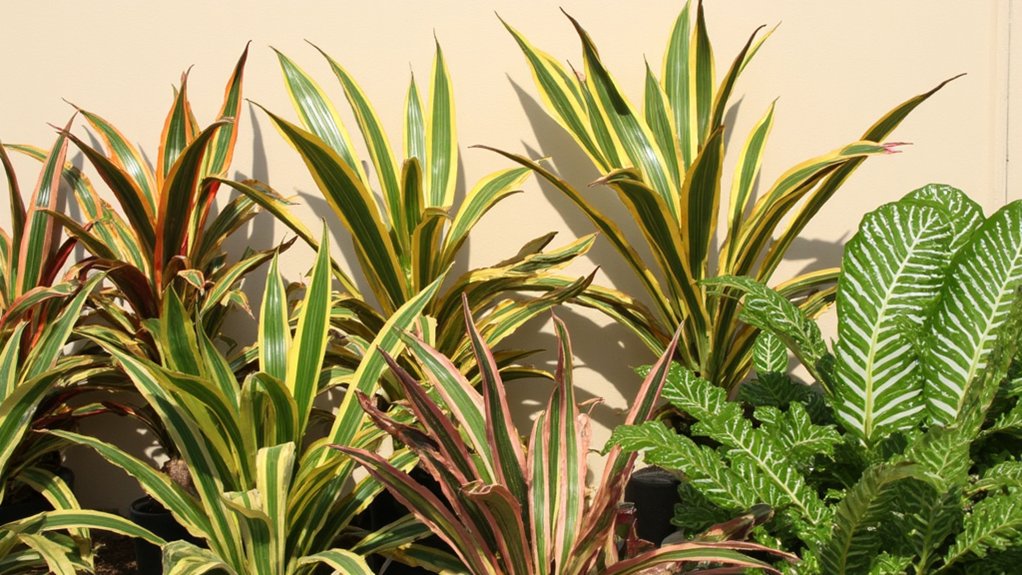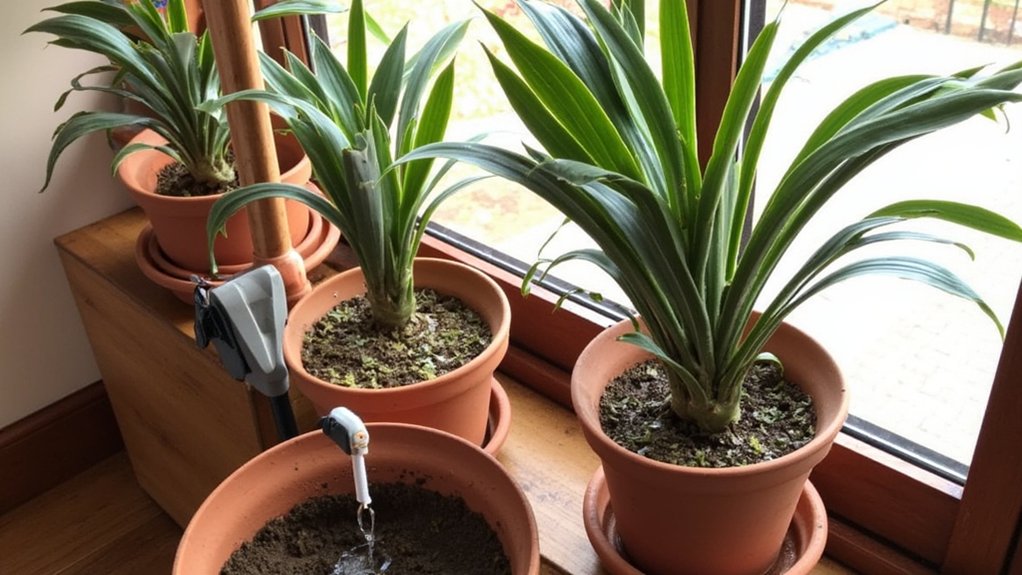When your Dracaena plant’s leaves start turning brown at the tips, you’re likely making one of several common care mistakes. You’ll find that these resilient houseplants can thrive for years with the right balance of light, water, and attention. As a tropical plant that’s adapted well to indoor environments, your Dracaena won’t demand constant maintenance, but it does have specific needs that set it apart from other houseplants. Let’s explore what’s keeping your Dracaena from reaching its full potential.
Contents
- 1 Understanding Different Dracaena Varieties
- 2 Light Requirements and Placement
- 3 Watering Guidelines and Moisture Needs
- 4 Soil Selection and Potting Tips
- 5 Temperature and Humidity Management
- 6 Fertilizing Your Dracaena Plant
- 7 Pruning and Maintenance Techniques
- 8 Common Pests and Disease Solutions
- 9 Propagation Methods and Tips
Understanding Different Dracaena Varieties

Whether you’re new to houseplants or an experienced indoor gardener, understanding the different Dracaena varieties will help you choose the perfect plant for your space. You’ll commonly find Dracaena marginata (Dragon Tree), with its thin red-edged leaves, and Dracaena fragrans (Corn Plant), featuring broader, yellow-striped foliage.
For smaller spaces, try the compact Dracaena compacta, which grows to 4-6 feet, or Janet Craig, with its dark green, glossy leaves. If you’re after dramatic flair, you can’t go wrong with Dracaena reflexa (Song of India), known for its yellow-variegated leaves, or Dracaena deremensis (Warneckii), displaying bold white stripes.
Light Requirements and Placement
Light plays an essential role in keeping your Dracaena healthy and vibrant indoors. Place your plant in bright, indirect sunlight, ideally 3-6 feet from a north or east-facing window. While Dracaenas can tolerate lower light conditions, they’ll grow slower and may lose their distinctive leaf coloring.
Avoid exposing your Dracaena to direct sunlight, which can scorch the leaves and create brown spots. If you notice the leaves becoming pale or the variegation fading, your plant needs more light. During winter months, you might need to move your plant closer to the window to compensate for reduced daylight hours.
Watering Guidelines and Moisture Needs

Proper watering makes the difference between a thriving Dracaena and one that struggles to survive. You’ll want to water thoroughly when the top 1-2 inches of soil feels dry to the touch, typically every 7-10 days during growing season and less frequently in winter.
Never let your Dracaena sit in standing water, as this can lead to root rot. Instead, water until it flows from the drainage holes, then empty the saucer after 15 minutes. If you notice brown leaf tips, you’re either underwatering or using fluoride-rich tap water – switch to filtered or distilled water for best results.
Soil Selection and Potting Tips
Successful Dracaena growth starts with choosing the right potting mix. You’ll want a well-draining, loose soil that’s rich in organic matter. Mix two parts standard potting soil with one part perlite or coarse sand to create the ideal growing medium.
Select a container that’s 2 inches wider than your plant’s root ball, ensuring it has drainage holes. Place a layer of gravel at the bottom, then fill one-third with your soil mix. When repotting, gently loosen the root ball and position it so the crown sits slightly above soil level. Fill in the sides, leaving 1 inch of space at the top for watering.
Temperature and Humidity Management

With your Dracaena now properly potted, maintaining ideal environmental conditions becomes your next focus. Keep your plant in temperatures between 65-80°F (18-27°C), and don’t let it drop below 55°F (13°C) at night. You’ll want to avoid placing it near drafty windows or AC vents.
Humidity should stay between 40-50%, which you can achieve by misting the leaves twice weekly or using a pebble tray filled with water. During winter months, when indoor heating systems run frequently, you’ll need to increase humidity. Consider grouping your Dracaena with other plants or running a humidifier nearby for best moisture levels.
Fertilizing Your Dracaena Plant
Feeding your Dracaena plant requires careful timing and moderation throughout the growing season. You’ll want to fertilize monthly from spring through early fall using a balanced, water-soluble fertilizer (10-10-10 or 20-20-20) diluted to half strength.
During winter, your plant doesn’t need fertilizer since it’s in its dormant phase. When you do feed it, apply the solution right after watering to prevent root burn. Make sure the soil is damp, not dry, before fertilizing.
If you notice brown leaf tips or yellowing leaves, you might be over-fertilizing. Scale back to feeding every six weeks instead of monthly, and always measure carefully.
Pruning and Maintenance Techniques
Regular maintenance keeps your Dracaena looking its best, and pruning plays a key part in this process. You’ll want to remove any yellow or brown leaves by cutting them off at the base, using clean, sharp scissors or pruning shears.
To control height, cut the main stem at your desired level, making a 45-degree angle cut just above a leaf node. Don’t worry – new growth will emerge from this point within a few weeks. For bushier growth, trim the tips of stems periodically during the growing season.
Remember to wipe your plant’s leaves monthly with a damp cloth to remove dust and maintain healthy photosynthesis.
Common Pests and Disease Solutions
Although Dracaena plants are generally resistant to pests, they can occasionally fall victim to spider mites, mealybugs, and scale insects. You’ll notice spider mites by their fine webbing and tiny specks moving on leaves, while mealybugs appear as white, cotton-like clusters at leaf joints.
To treat infestations, first isolate your plant, then spray leaves with insecticidal soap every 5-7 days. For stubborn cases, dip a cotton swab in 70% isopropyl alcohol and directly apply it to visible pests. Root rot, caused by overwatering, can be prevented by ensuring proper drainage and letting soil dry between waterings.
Propagation Methods and Tips
Dracaena plants offer multiple propagation methods that you’ll find surprisingly straightforward to execute at home. The most reliable technique is stem cutting, where you’ll cut 6-8 inch segments from healthy stems using clean, sharp scissors.
For successful propagation, remove the lower leaves, dip the cut end in rooting hormone, and place it in water or well-draining potting mix. If using water, change it weekly and wait for roots to develop, which typically takes 3-4 weeks.
You can also propagate through cane division, separating mature plants at the roots during repotting. Ascertain each division has healthy roots and at least one growing point.
